The Thirty Tyrants › Lysimachus » Ancient origins
Articles and Definitions › Contents
- The Thirty Tyrants › Antique Origins
- Lysimachus › Who Was
Ancient civilizations › Historical and archaeological sites
The Thirty Tyrants › Antique Origins
Definition and Origins
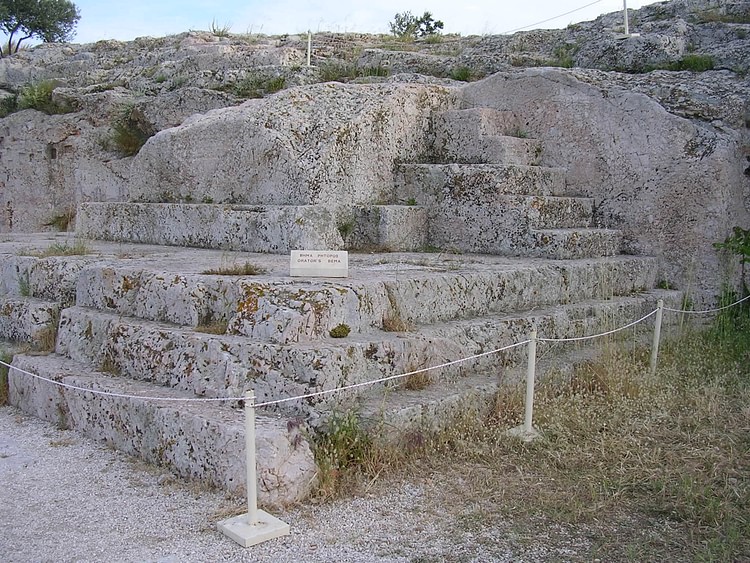
The Thirty Tyrants (οἱ τριάκοντα τύραννοι) is a term first used by Polycrates in a speech praising Thrasybulus ( Arist. Rhet.1401a) to describe the brief 8-month oligarchy which governed Athens after the Peloponnesian War – roughly late-summer 404 BCE to early-summer 403 BCE – also called simply “the Thirty.” The Thirty's rule became marked with such brutal and repressive actions that “oligarchy” emerged from it so discredited Athenians refused to consider “rule by the few” a respectable alternative to democracy for three generations.
ANCIENT SOURCES
Our information on the Thirty comes primarily from Xenophon, the Aristotelian Athenaion Politeia, Diodorus Siculus, and Justin with additional information from Plutarch, Pausanias, and Nepos. We also possess numerous mentions of the regime in the speeches of Andocides, Lysias, Demosthenes, and Isocrates. Unfortunately, not all of these sources agree with each other and scholars must make reasoned inferences regarding several key events.
Although Xenophon, who lived through the time of the regime, never uses the term Thirty Tyrants, he describes their rule as τύραννειν or tyrannein, lit. “to be sole ruler” (Xen. Hell. 2.4.1; cf. 23.16; 6.3.8). Other authors use the term δυναστεία or dynasteia, lit. “power” or “lordship” (eg Andoc. 2.27; Plat. Epist. 7.325a; [Arist.] Ath. Pol. 36.1). The title The Thirty Tyrants had nonetheless become the standard designation at the time of Diodorus and Justin.
HISTORICAL BACKGROUND
About November 405 BCE, the Athenians, led by Theramenes, entered into extended negotiations with the Spartans to capitulate, prompted by the Spartan naval victory at Aegospotami, which had effectively ended the Peloponnesian War.
Although the Corinthians, Thebans, and other poleis urged for the destruction of Athens, the Spartans successfully argued that the Greeks could not “pluck-out one of Greece ’s two eyes” (Justin 5.8.4). The Spartans instead demanded the Athenians destroy their Long Walls and fortifications about Piraeus. The Athenians would also recall all exiles and withdraw both their magistrates and cleruchies (settlements) from all other poleis territories. Moreover, the Athenians would now have “the same friends and enemies” as the Lacedaemonians (Xen. Hell. 2.2.20; Diod. 13.107.4; 14.3.2; Plut. Vit. Lys. 14.4; Andoc. 3.11-12, 39; Lys. 13.14). At the same time, the Spartans demanded the Athenians recraft their laws to favor oligarchy ([Arist.] Ath. Pol. 34.3). The Athenians accepted these conditions by early April 404 BCE.

Piraeus & The Long Walls
The Athenians appointed 5 Ephors (overseers) to organize all voting through Phylarchoi (Tribal Rulers). The Athenian Ekklesia (Assembly) soon divided into three camps: those who favored a patrios politeia (ancestral constitution), those who desired to keep a democracy, and those who wanted an oligarchy. Debate and inaction continued through September 404 BCE, opposition to any resolution led primarily by the democratic faction, until the growing delay forced the Spartans to intervene.
The Spartans instructed the Athenians to choose 30 men to manage all the affairs of the polis. Theramenes, the de factoleader of the democrats, nominated 10 of these men, the 5 Ephors nominated 10, while the Ekklesia would elect those 20 and choose the final 10. These 30 men would then “draw-up the patrios nomoi (ancestral laws) according to which [the Thirty] would govern” (Xen. Hell. 2.3.2; Diod. 14.4.1).
THE THIRTY
The 30 Athenians elected were: Aeschines (not the orator), Dracontide, Mnesitheides, Anaetius, Erasistratus of Acharnae, Onomacles, Aresias, Eratosthenes, Peison, Aristoteles, Eucleides, Phaedrias, Chaereleos, Eumathes, Pheido, Charicles son of Apollodorus, Hiero, Polychares, Chremo, Hippolochus, Sophocles (not the playwright), Cleomedes son of Lycomedes, Hippomachus, Theogenes, Critias son of Callaeschrus, Melobius, Theognis, Diocles, Mnesilochus, Theramenes son of Hagnon.
THE AIMS OF THE THIRTY
The Thirty at first avoided crafting a definite constitution. They sought instead to a) establish an interim functioning government; b) eliminate opponents; and c) reform the laws they thought “problematic.”
Interim Government: The Thirty re-established the Boule (Council of 500) and (re-)appointed other magistrates such as the 9 Archons (Leaders), The Eleven (Prison Magistrates), the Strategoi (Military Commanders), as well as the Board of Ten Treasurers of Athena and the Other Gods among other miscellaneous appurtenances of the democracy. The Thirty, however, also created “The Ten,” 10 men supervised by The Thirty who would rule Piraeus. The Thirty also hired 300 Mastigophoroi (whip-bearing attendants) to act as a kind of police force.
Eliminate Opponents: The Thirty presided over a trial in the Boule against the previous strategoi, taxiarchs (brigadiers), and miscellaneous others, who had opposed peace with Sparta. Though the Thirty condemned many of these men to death, they did not confiscate their property. Soon after this trial, the Thirty declared they must purge “the polis of unjust men and the rest of the citizens inclined against virtue and injustice” (Lys. 12.5). They executed sycophants, thieves, bribers, and other “undesirables” after more trials before the Boule. The Athenians generally accepted these initial actions as necessary (Xen. Hell. 2.3.12; [Arist.] Ath. Pol. 35.3; Diod. 14.4.2; Lys. 25.19).
Reform the Laws: The Thirty rescinded various grants of citizenship to foreigners and revoked several proxenies(ambassadorships, lit. "compacts of friendship"). They also erased the laws of Ephialtes and Archestratus, and thus by consequence expanded the power of the Areopagus (High Court of Appeal). The Thirty then began to edit the Laws of Soloninscribed and posted next to the Royal Stoa. They also reoriented the Pnyx (the Ekklesia Meeting Place) so as to limit the maximum size of those gatherings. Finally, they had the Eleven report directly to them instead of the courts.
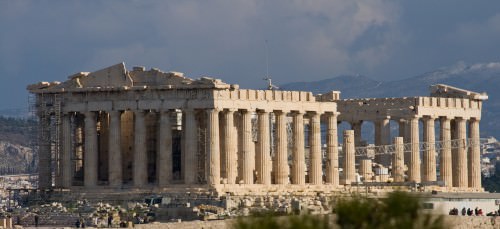
The Parthenon
THE THIRTY IN PRACTICE
During these events, however, fractures began to develop within the ranks of The Thirty. Most of the group, it seems, desired more radical changes. hey apparently wanted to remake Athens into a model of Sparta. They sought to imitate the Spartan γερουσία or gerousia (“Council of Elders”), the Ὅμοιοι or homoioi (“The Equals,” lit. “those who are alike”), and the περίοικοι or perioikoi (“free non-citizens,” lit. “dwellers about”) of Lacedaemonian society.
The Thirty would serve as the Athenian gerousia. They would then designate “the included,” the “best” or “most suitable” men to become the Athenian equivalent of the homoioi. The Thirty then “excluded” the rest of the population, making them perioikoi(remain free but not considered Athenian citizens).
It appears that additional disagreements occurred within the Thirty over precisely how this new government would function, ie how much power resided with the Thirty versus the role of the included. The Thirty, moreover, never disbanded the Boule.When the Thirty wished to have the approval of a larger group, they typically appeared before the Boule. Still, a small group within the Thirty, led again by Theramenes, sought to expand the franchise of the “included” to 5,000, but the stricter oligarchic faction led by Critias and Charicles prevailed and chose to include only those 3,000 whom the Thirty felt most supported the new government.
By February 403 BCE, only the 3,000 could live inside the asty ( city -proper) of Athens. The excluded had to relocate elsewhere about Attica, and the Thirty proceeded to confiscate their property. As a result of these actions, many Athenians began to flee to neighboring poleis like Boeotia, Cornith, Argos, Chalcis, Megara, and Oropus and thus became fugitives.
AN INCREASING TYRANNY
About this time, the Athenian exile Thrasybulus led a group of approximately 70 men and seized the defensible hill Phyle north of Athens. Although a relatively small force, the Thirty responded to this threat by leading the 3,000 out of Athens to blockade the encampment. Bad weather, however, forced them to withdraw.
Thrasybulus' armed threat fractured the fragile unity of the Thirty between those who still desired narrow oligarchy against those who still desired to increase the Athenian franchise. Critias and Charicles prevailed again, and, after the Boule gave the Thirty power to decide life or death over the excluded, Critias removed Theramenes' name from the list of the included and had him executed.
The Thirty continued to revise the list of the “included” as they saw fit. A growing number of Athenians became alarmed as the Thirty now seemed to execute men not for crimes but for motives of faction (Lys. 30.13). The Thirty then disarmed the excluded and deposited their weapons on the Acropolis. Shortly thereafter, the Thirty's growing fear as well as greed and a ruthless determination to eliminate all opposition drove them to execute prominent men in much greater numbers. The sources agree that about 1,500 Athenians died under the Thirty.
The Spartans had also issued decrees to other Greek poleis. They were to surrender any Athenian fugitives to the Thirty. Most of the Greeks complied, but Argos and Thebes refused.
By May 403 BCE, about 700 men had gathered with Thrasybulus at Phyle: some 100 Athenians, 300 foreigners, and 300 mercenaries hired by the metic (foreign resident) Lysias. The Thirty proceeded to seize Eleusis and Salamis. The Thirty executed an additional 300 men by vote of the 3,000. The Thirty attempted to reconcile with Thrasybulus and offered him Theramenes' place. Thrasybulus refused. He instead demanded the Thirty establish the patrios politeia.
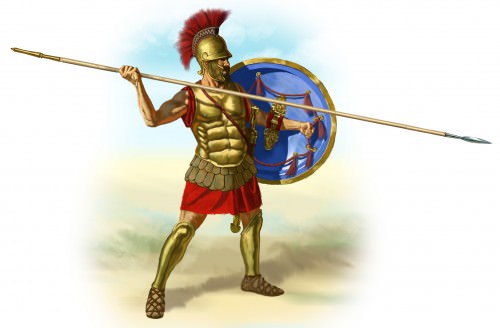
Greek Hoplite
THE DEFEAT OF THE THIRTY
At the behest of the Thirty, the Spartans sent an armed garrison to Athens to assist the Thirty in countering Thrasybulus' now growing threat. When the Thirty again dispatched a small force to seize Phyle, led by the Lacedaemonians, Thrasybulus counter attacked. He routed the force and immediately proceeded to Piraeus. Thrasybulus reached Mounichia Hill with some 1,200 men.
The Thirty attacked with an armed force from the 3,000 again. They lost about 70 men and both Critias and Hippomachus fell during the fierce battle. More importantly, the oligarchs failed to overcome the men occupying Piraeus. Some Athenians in the polis now wanted to depose the Thirty, while others still refused to yield to the men in Piraeus. Those of the Thirty and the Ten still alive, as well as the Eleven, all fled to Eleusis. They left another 10 men in charge of Athens itself.
This new Board of Ten attempted to attack Piraeus one more time but failed and soon found Athens besieged by Thrasybulus' forces. Because of internal divisions within Sparta, the Spartans responded tepidly to these events. Although they initiated a naval blockade on Piraeus, they also suffered defeat in another hoplite battle against the men still occupying Piraeus. The Spartans had now begun to grow weary of Athenian infighting. The ongoing conflict, moreover, began to fracture the Spartan League (the Corinthians and Boeotians, for example, refused to assist Sparta against the Athenians in Peiraieus ).Consequently, when Sparta declined to offer any further overt support to the Thirty or the Board of Ten in Athens, the oligarchy collapsed. The Spartans assisted in mediating a settlement between the men occupying Piraeus and those of the 3,000 still in Athens and then withdrew from Attica.
The two sides agreed that peace would ensue and that each Athenian return to his own possessions except for the property of the Thirty, the Eleven, and the original Ten. Those groups and their more prominent supporters could all remain in Eleusis (Xen. Hell. 2.4). If any of them wished to return to Athens, then they could offer euthynai (submit to an investigation of their conduct while serving in office). Finally, the Athenians swore oaths of amnesty not to remember past wrongs.
One last conflict, however, occurred between the remaining Athenian oligarchs residing in Eleusis and the restored democracy of Athens. Some of the returning exiles now wished to ignore the amnesty and avenge themselves against the survivors residing in Eleusis. When word also reached Athens that the remaining oligarchs had in fact begun to hire mercenaries, the Athenians marched en masse to besiege Eleusis.
AFTERMATH
Under the ruse of a conference to negotiate a settlement, the Athenians killed all of the oligarch's military commanders. The final fate of the surviving Thirty, the Eleven, and the Ten remains unknown. Justin says the tyranny died, while the orator Isocrates attests “those most responsible for the evils” were killed during that final conflict, but they both remain unclear as to the precise number or identity of the victims.
The restored democracy nonetheless confiscated the property of the Thirty, the Eleven, and the Ten as well as the property of the oligarchy's more prominent supporters. As a result of the Thirty's actions during their rule, the Athenians abandoned even entertaining the idea of “oligarchic rule” for the next forty years.
Lysimachus › Who Was
Definition and Origins
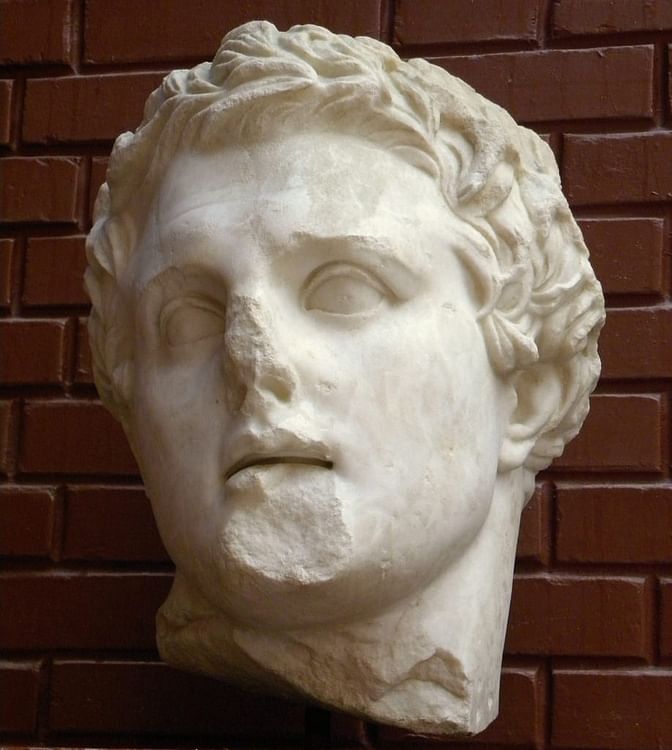
Lysimachus (c. 361-281 BCE) was one of Alexander the Great ’s trusted bodyguards and a member of his Companion Cavalry. Although he obtained Macedonian citizenship, his father was a Thessalian named Agathocles. After Alexander ’s death in 323 BCE, Lysimachus benefitted from his loyalty to the king by being rewarded with the strategically important province of Thrace, an area northeast of Macedon along the Black Sea coast. While he initially remained relatively uninvolved in the series of wars that immediately followed Alexander's death, he eventually sought to expand his land holdings and ultimately joined his fellow commanders in a war against Antigonus Monophthalmus (the One-Eyed) and his son Demetrius I of Macedon. Success would follow but at a hefty price.
ALEXANDER'S BODYGUARD
Educated at the royal court in Pella, Lysimachus rose to become a prominent member of the king's entourage, one of his bodyguards or somatophylax by 328 BCE. Oddly enough, there was another Lysimachus in the entourage of Alexander. This second Lysimachus was one of the king's former tutors, better known, as one historian stated, for his sense of humor rather than hygiene. He called the young Alexander Achilles while he referred to himself as Phoenix, Achilles' tutor. Although historians record that he accompanied the king on the invasion of Persia, his only appearance of note was at the siege of Tyre.
There is some disagreement over the exact year of Lysimachus's birth. Some historians give the year as 361 BCE while others say he was born around 355 or 351 BCE in Pella, the capital of Macedon. The earlier date is more plausible. If he had been born in 355 BCE or later, he would have been too young to have accompanied the king to Persia as a bodyguard. Although early histories state that he accompanied the king in his war against the Persians and King Darius, little is known about Lysimachus participation before Hydaspes. Historians write of his involvement in Alexander's battle of the Hydaspes against King Porus - it was recorded that he crossed the river with the king - and the siege of the Indian city of Sangala. Apparently, he was wounded at this siege. The historian Arrian, in his The Campaigns of Alexander, wrote,
Throughout the siege Alexander lost a little under 100 men; the number of wounded, however, was disproportionately large – over 1,000, among them being Lysimachus, of Alexander's personal guard, and other officers. (290)
For this bravery and loyalty to the king, he was rewarded with Thrace whose importance lay in its location adjacent to the Hellespont, the bridge between Asia and Europe.
GOVERNOR OF THRACE
On June 10, 323 BCE, Alexander the Great died in Babylon. Historians, both past and present, argue over the exact cause, nevertheless, he died without naming a successor or heir, causing his empire to descend into chaos. Although the commander Perdiccas possessed the king's signet ring, arguments persisted and no consensus could be reached. While waiting for Alexander's son, the future Alexander IV, to come of age, the commanders divided the empire among themselves - Ptolemy Itook Egypt, the elderly Antigonus obtained parts of Asia Minor, the regent Antipater I retained Macedon and Greece, and lastly, Lysimachus received Thrace. His fellow bodyguard Lennonatas accepted the province of Phrygia, located across on the Asian side of the Hellespont - an arrangement that caused constant friction between the two.
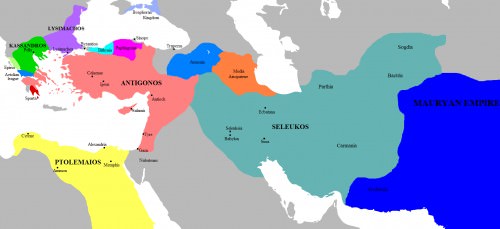
Map of the Successor Kingdoms, c. 303 BCE
For the next three decades, alliances would be made and broken. Enemies became friends, and friends became enemies. The empire that Alexander had built would never be reunited. His mother, wife, and only son and heir would die on the orders of Cassander, Antipater's son, never having sat on the throne.
LYSIMACHUS CONCENTRATED HIS EFFORTS ON ESTABLISHING A STRONG POWER BASE IN THRACE AND AVOIDED GETTING INVOLVED IN THE WARS OF SUCCESSION.
Lysimachus' first duty upon his arrival in Thrace was to pacify the diverse Thracian tribes. Although the Thracians joined in the fight against Darius, they had always been a people antagonistic to both Philip II and Alexander. The young ruler immediately established himself against the leader of a key Thracian dynasty, the Seuthes. Since the majority of Alexander's empire had been divided among his more prominent commanders, they busied themselves in what became known as the Wars of Succession or Wars of Diadochi. Since they fought among themselves with little interest in either Thrace or Phrygia, Lysimachus realized his good fortune and avoided getting involved. In Thrace he was fairly safe from the intrigues and scheming of his fellow commanders - no one outside the province challenged him - at least for a while. He concentrated his efforts on establishing a strong power base, but at one point, in 315 BCE he was forced to suppress a revolt staged by one of the cities along the Black Sea coast.
Eyeing the strategically important province for himself, the commander Antigonus who reigned over much of Asia Minor sent a small contingency to aid the city and provoke the local tribes. Finally, in 311 BCE, peace was achieved with Lysimachus remaining in control of the hostile city. This revolt would finally draw him into the conflict that he had so long sought to avoid.He formed an alliance with Cassander of Macedon, Ptolemy, and Seleucus I. To safeguard the area and secure the Dardanelles, he promptly built a new city in 309 BCE, Lysimachia, on the Gallipoli peninsula.
FAMILY AFFAIRS
From the time he was named ruler until his death in 281 BCE, Lysimachus used marriage to secure his position in Thrace and establish necessary beneficial alliances. After the commander Perdiccas, who would soon die at the hands of his own men, refused to marry Antipater's daughter Nicaea, the wise Thracian ruler married her in 321 BCE, securing an alliance with both Antipater and his son Cassander. They would have three children: one son, Agathocles, and two daughters. Lysimachus would later support his brother-in-law against Polyperchon for the regency of Macedon and Greece. After the death of Nicaea, he chose to marry the daughter of Ptolemy I and his mistress Bernice, Arsinoe II, around 300 BCE. It was a marriage he would regret. For reasons unknown (probably to secure the throne of Thrace for her own son), Arsinoe convinced her husband to kill his oldest son and heir Agathokles on the trumped-up charges of treason. The murder of the popular young commander caused an uproar among many of his fellow officers who chose to desert to the army of Seleucus, now the adversary of Ptolemy. After Lysimachus' death, she would marry her half-brother Ptolemy II, establishing the precedent of brother-sister marriages in Egypt.
WARS OF THE DIADOCHI
Like many other commanders, Lysimachus assumed the title of king in 305 BCE. With the memory of Antigonus' recent attack fresh in his memory, the king set his expansion sights on Asia Minor. He allied with Seleucus and Cassander against the elderly Antigonus and his son Demetrius at the Battle of Ipsus in 301 BCE; a battle that would bring about both the defeat and death of Antigonus. According to the terms of peace, Lysimachus was rewarded with additional lands in Asia Minor to the south of the Taurus Mountains, Seleucus received Syria, and Cassander's position was established securely in Macedon and Greece. According to many historians, the battle put an end to any hope of re-establishing Alexander's empire.
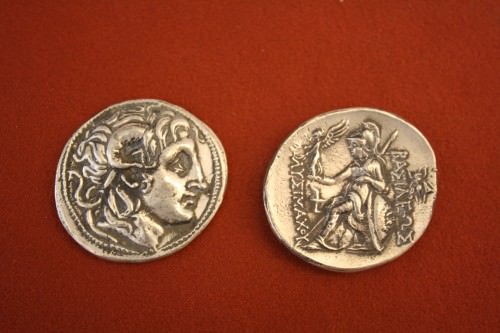
Thracian Silver Tetradrachm
The riches of the area around Pergamon along the Mediterranean coast of Asia Minor helped Lysimachus to expand his territory further. After the death of Cassander in 297 BCE, he set his sights on Macedon. With the assistance of King Pyrrhusof Epirus, he moved across the border and forced Demetrius out. Demetrius and his army moved across the Hellespont and into Asia Minor, confronting the forces Seleucus. Unfortunately for the one-time ruler of Macedon, he was immediately captured only to die in captivity in 283 BCE. Lysimachus' hopes for expansion were temporarily halted when he was captured in 292 BCE by Dromichaites, the king of Getae. He was forced to not only buy his freedom but also surrender a portion of his Trans-Danubian territory. In 282 BCE his one-time ally Seleucus set his sights on Lysimachus's territory in Asia Minor. In 281 BCE the two armies met at Corupedium where the king of Thrace met his death. With no heir, his small piece of the empire would fall into disarray.
MAP
LICENSE:
Article based on information obtained from these sources:with permission from the Website Ancient History Encyclopedia
Content is available under License Creative Commons: Attribution-NonCommercial-ShareAlike 3.0 Unported. CC-BY-NC-SA License